Schedule
The Canon and Beyond: Teaching the History of Modern Design

Final Schedule, Essential, and Suggested Readings
Sunday, July 5
Participants arrive in Philadelphia.
10 AM to 6 PM: Registration – URBN Center Lobby, 3501 Market Street
Evening – Unpacking, settling-in
Monday, July 6
9:15 AM – 12:15 PM, URBN Center, room 345
Institute Introduction: David Raizman and Carma Gorman. Welcome and introduction of staff and summer scholars; Institute goals and objectives; design history as an emerging field of study in the United States; discussion/dialogue (Gorman)
- Essential Reading: Fallan, Kjetil, Design History: Understanding Theory and Method, Oxford and New York, Oxford University Press, 2010, 1-54; Raizman, David, History of Modern Design, 2e, Upper Saddle River, NJ, Pearson, 2010, 9-11; Woodham, Jonathan, Design in the 20th Century, Oxford and New York: Oxford University Press, 1999, 7-9; Forty, Adrian, Objects of Desire, London, Thames & Hudson, 1986, 6-10; Louis Menand, “Why We Have College,” New Yorker, June 6, 2011, 74-79; Buchanan, Richard, review of Woodham Design in the 20th Century, Journal of Design History, vol. 11, no. 3 (1998), 259-263.
2:15 – 4:45 PM, URBN Center, room 345
Thematic Unit I: Seminar will discuss the role of Taste in the history of design, focusing upon the relationship among elite, popular, and mass taste and how taste has functioned culturally beginning in the 19th century. See Blackboard/Learn for introductory text and powerpoint (https://partners.dcollege.net/).
12:30 – 2:00 PM – Summer Scholars to Creese Student Center with Mandi to get Drexel IDs and other housekeeping; break for lunch
- Reading: essential: Excerpt from Thomas Hope, Household Furniture and Interior Decoration (1807), 1-7; Gorman, Carma, ed., The Industrial Design Reader (New York, Allworth Press, 2003) - essays by A.W.N. Pugin, Owen Jones, Charles Eastlake, Edgar Kaufmann, Jr., Dieter Rams, and Dorothy Radice; Meikle, Jeffrey L., Design in the USA,
Oxford and New York: Oxford University Press, 2005, 89-129; 131-174); Hine, Thomas, Populuxe, New York, Knopf, 1986, 3-14; 82-106; Herbert Gans, “Design and The Consumer: A View of the Sociology and Culture of ‘Good Design’,” in Design Since 1945, eds. K. Hiesinger and G. Marcus, Philadelphia, 1983, 31-36.
- Suggested: Raizman, HoMD 2e, 57-146;161-253; Kirkham, Pat and Weber, Susan, et al., History of Design: Decorative Arts and Material Culture 1400-2000, New York, Bard Graduate Center, 2013, 416-435; 469-479; 596-653; Karal Ann Marling, As Seen on TV: the Visual Culture of Everyday Live in the 1950s, Cambridge, MA; Harvard University Press, 1996; Kenichi Ohmae, “Global Products” (in Carma’s Industrial Design Reader)
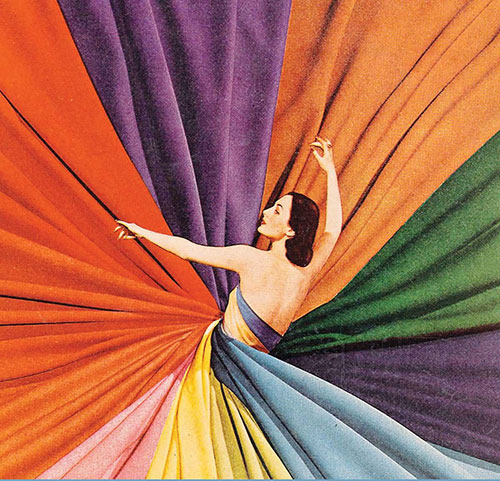
From an advertisement for Monsanto Chemical Corporation, February 1946
Tuesday July 7
9:30 AM – 12:30 PM, URBN Center, room 345
Regina Blaszczyk will lead an in-depth seminar focusing upon design for mass markets using case studies from fashion, textiles, and synthetic materials.
- Essential Reading: Hounshell, David A., From the American System to Mass Production (1984), chap. 2, “The Sewing Machine & The American System of Manufactures,” 67-123, and Meikle, Jeffrey L., Twentieth-Century Limited, 1979, chap. 3, “The New Industrial Designers,” 39-67.
- Additional Reading Suggestions: Marchand, Roland, Advertising the American Dream, 1985, chap. 5, “The Consumption Ethic: Strategies of Art and Style,” 117-163; Meikle, American Plastic, 1995, chap. 5, “Nylon: Domesticating the New Synthetic,” 125-152;
12:15-1:15 – Break for Lunch
11:15 – 4:30: Field Trip: Meet outside URBN Center for bus to the Philadelphia Museum of Art: Viewing of decorative arts and design galleries 19th and early 20th century with Reggie, David, and curator Elisabeth Agro; visit to the 19th century American glass collection; and visit to PMA storage for a look at craft not on display in the galleries; discussion/dialogue to include the role of the museum in shaping the history of design.
Wednesday July 8
9:30 AM – 12:30 PM, URBN Center, room 345
Reggie will lead a second seminar focusing upon newer interpretations of mass-market design, business, and consumer culture
- Essential Reading: Blaszczyk, "Cinderella Stories" in Imagining Consumers; Blaszczyk, “The Hidden Spaces of Fashion Production in Sandy Black et al, eds., The Handbook of Fashion Studies (London, 2013)
- Additional Reading Suggestions:: Blaszczyk, Regina Lee, The Color Revolution, 2012, chap. 5, “True Blue,” 115-138; White, Roger B., “An Exposition of Our Own: Corporate Identity, Consumer Advertising, and Atlantic City’s National Exhibits,” Journal of Design History 26, 2013, 47-64; Scott, Peter, The Making of the Modern British Home, 2013, chap. 7, “Equipping the Suburban Home,” 152-193.
12:30 – 1:30 PM – Break for Lunch
1:30 – 4:30 – Korman Center (see campus map in registration packet), room TBD
Project Faculty Carma Gorman will lead a discussion that examines the impact of US intellectual property law on American design of the 1940s and 1950s. After introducing participants to the unusual configuration of US patent, copyright, and design patent law, she will suggest that American manufacturers responded to the constraints and affordances of US intellectual property law either by producing “borax” works adorned with applied ornament (in order to secure copyright or design patent protection), or by producing functionalist works that were in some way technologically novel (in order to secure utility patent protection). Gorman concludes that the distinction between “lowbrow” and “highbrow” tastes in the mid-century USA was related not only to designers’ and consumers’ social class and aesthetic preferences, but also to manufacturers’ desire to find effective ways of protecting their designs against copycats.
- Essential Reading: Edgar J. Kaufmann, jr., “Borax, or the Chromium-Plated Calf”; Architectural Review 6, no. 4 (August 1948): 88-91; Carma Gorman, “Law as a Lens for Understanding Design,” Design and Culture 6, no. 3 (November 2014): 269-290; Stina Teilmann-Lock, “Danish Design: Legal Restrictions and Creative Responses,” Design and Culture 6, no. 3 (November 2014): 291-302; Eero Saarinen, Shaped Chair, US (Utility) Patent 2,541,835; Eero Saarinen, Chair or the Like, US (Design) Patent D158508.
Optional: For those who want a primer on the different kinds of intellectual property protection available in the USA: “Understanding Different Types of IPRs,” module 3 of the Understanding Intellectual Property Rights video tutorial at http://origin.www.stopfakes.gov/tutorials/data/us/menu/index.htm (or, if you prefer, read pp. 9-27 of the pdf of the video transcript, which is downloadable from the same page or from Blackboard).
Thursday July 9
8:30 AM – Field Trip: meet outside the front entrance to the URBN Center. We’re visiting the Hagley Museum and Library, Delaware – with Reggie, Carma, and David; box lunches at the Hagley Museum.
Here is our tentative schedule:
Arrive at Hagley by bus at 10 a.m.; depart at 4 or 4:30 p.m.
10-11:30, Visit to the imprints collection and the stacks in the imprints department, with special emphasis on trade catalogs and trade journals that can be used to research design history. This visit will be hosted by the head of imprints.
11:30-11:45. Walk over to the Soda House, where the archives are stored and where Lynna and her staff have their offices.
11:45-1. Show and tell of design-related archives by Lynn and her staff. Highlights include materials from the following collections: Raymond Loewy, MCI, and DuPont. There will be a special table of color cards, color swatches, telegraphs, and scrapbooks from the large collection of papers from the Textile Color Card Association of the US, as a tie-in to The Color Revolution.
1:00-1:45. "Brown bag" lunches will be available for the summer scholars in the Soda House. Lynn can liaise with Mandi, the project's administrative assistant at Drexel, to put her in touch with the food service people on site at Hagley, who can then arrange the menu, veggie options, payment, etc.
1:45-3. Behind the scenes tour of the Hagley archives, both in the Soda House and in another location on the Hagley property.
3-4:30. Visit to the Powder Yards, where the summer scholars can tour an exhibition of hooked rugs. Some may oft to have a quick tour of the powder yards itself.
Friday July 10
9:30 AM – 12:15 AM. Introduction to participant group presentations (Raizman, Gorman, Blaszczyk); Groups meet among themselves to discuss topics; Institute Director, Project Faculty, and Visiting Scholar Blaszczyk will be available for consultation.
12:30 – 1:30 PM – Break for Lunch
1:30 – 4:00 PM: Participant Groups meet to begin working on topics in consultation with David and Reggie
Weekend July 11 - 12 - on your own - Relax; Enjoy; Explore!
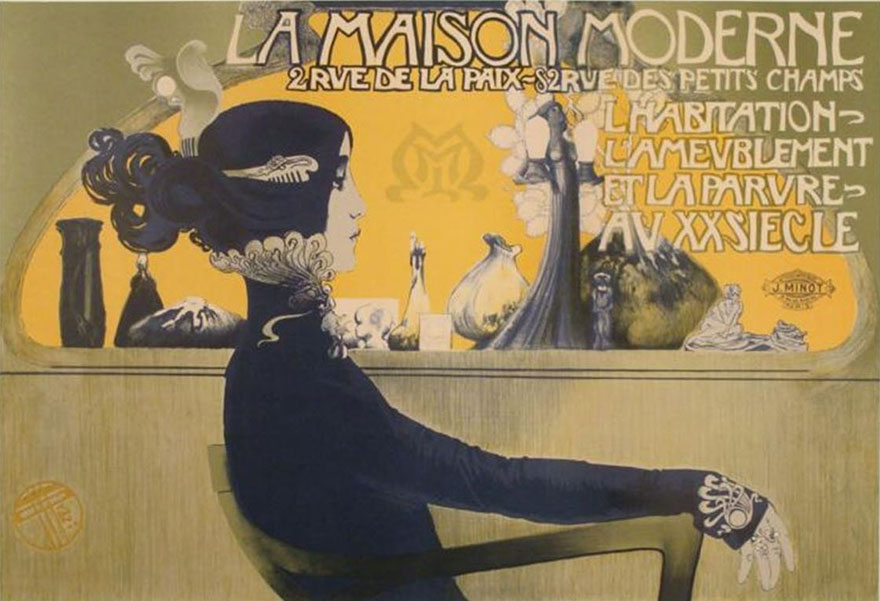
Manuel Orazio, Advertising Poster for “La Maison Moderne,” Paris, c. 1900
Monday July 13
9:30 AM – 12:15 PM: Thematic Unit II – seminar will discuss a selection of representative examples of women as producers, consumers, and objects of design from the 19th and 20th centuries; introductory text and powerpoint will be available on Blackboard/Learn for review prior to the seminar.
12:30 – 1:30 PM – Break for Lunch
1:30 – 4:30 PM: Women as Consumers and Producers of Design continued – screening of documentary film on Lucienne and Robin Day (“Contemporary Days”) courtesy of producer Murray Grigor); dialogue/discussion (Gorman)
- Essential Reading: Kirkham, Pat, ed., Women Designers in the USA 1900–2000: Diversity and Difference (New Haven: Yale University Press, 2000), 49-83; 85-100; Gorman, Carma, “Reshaping and Rethinking: Recent Feminist Scholarship on Design and Designers,” Design Issues, 17, no. 4, Autumn 2001, 72-88; Attfield, Judy and Kirkham, Pat, eds., A View from the Interior: Women and Design, 2nd edition, London, The Women’s Press, 1995, 206-214; Gronberg, Tag, “Working in Tandem,” Art History, 19, no. 2, 1996, 313-316; Hayden, Dolores, The Grand Domestic Revolution: A History of Feminist Design for American Homes, Neighborhood, and Cities, Cambridge MA and London, MIT Press, 1981, 3-29; Gorman, Carma, ed., The Industrial Design Reader (New York, Allworth Press, 2003), essays by Candace Wheeler, Belle Kogan, and Edward Carpenter.
- Additional Reading Suggestions: Weltge, Sigrid, Women’s Work: textile art from the Bauhaus, San Francisco, CA, Chronicle Books, 1993, 41-45; Thomson, Ellen Mazur, The Origins of Graphic Design in America 1870-1920, New Haven and London, Yale University Press, 1997, 133-158; Kirkham, Pat, Charles and Ray Eames: Designers of the Twentieth Century, Cambridge, Mass., MIT Press, 1995, 61-95.
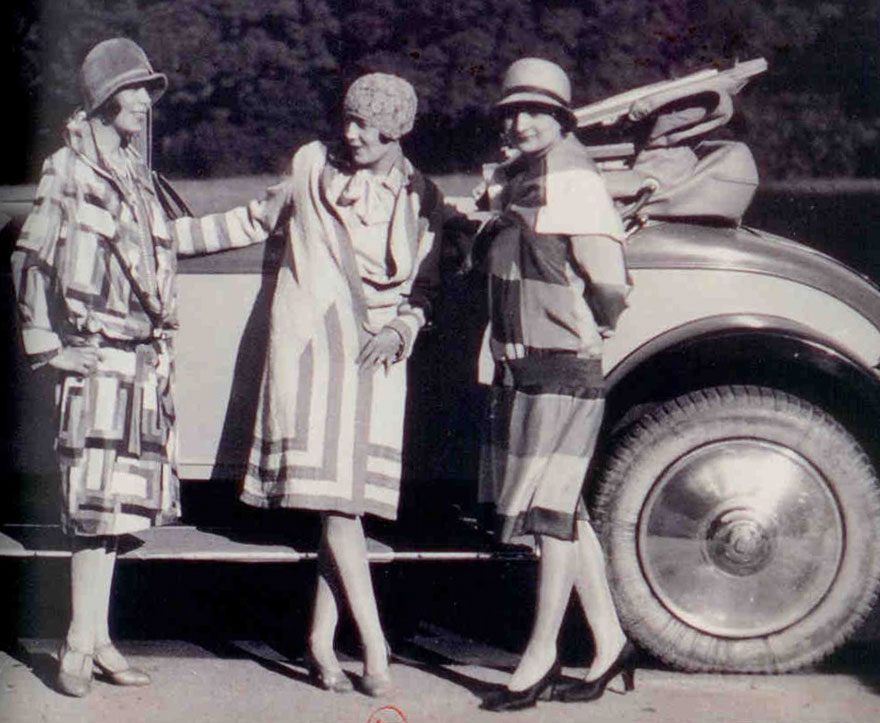
Models wearing Sonia Terk-Delaunay fashions, c. 1925
Tuesday July 14
9:30 AM – 12:15 PM: Maria Elena Buszek will conduct a seminar on feminist perspectives of women in design with a focus upon fashion
- Essential Reading: Buckley, Cheryl. “Made in Patriarchy: Theories of Women and Design- A Reworking,” in David Brody & Hazel Clark (eds.) Design Studies. A Reader. London: Berg, 2009; Clark, Hazel. “The Difference of Female Design,” in David Brody & Hazel Clark (eds.) Design Studies. A Reader. London: Berg, 2009; Dahan-Kalev, Henriette and Shoshana-Rose Marzel, “Fashion and Feminism,” in Marzel and Guy D. Stiebel (eds.), Dress and Ideology: Fashioning Identity from Antiquity to the Present. London: Bloomsbury, 2015.
- Additional Reading Suggestions: Gronberg, Tag. “Sonia Delaunay: Fashioning the Modern Woman,” Women: A Cultural Review, Vol. 13, Issue 3 (2002): 272-288; Evans, Caroline and Minna Thornton. “Fashion, Representation, Femininity,” Feminist Review, No. 38 (Summer 1991): 48-66; Gibson, Pamela Church. “Redressing the Balance: Patriarchy, Postmodernism and Feminism,” in Gibson and Stella Bruzzi (eds.), Fashion Cultures: Theories, Explorations, and Analysis. London: Routledge, 2000.
12:30 – 1:30 PM – Break for Lunch
1:30 – 4:00 PM: Visit to the Drexel Historic Costume Collection with Curator Clare Sauro, Maria, David, and Carma
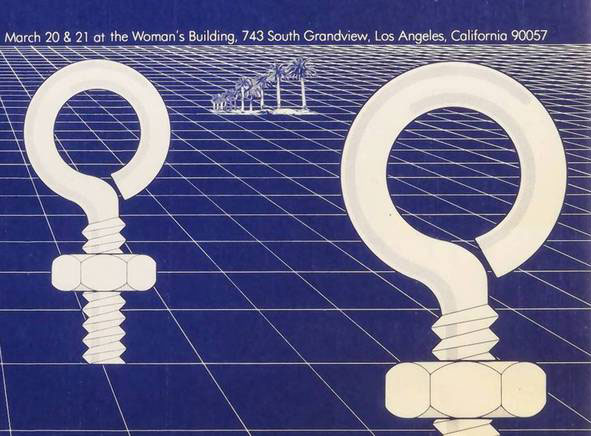
Sheila Levrant de Bretteville, “Everything Loose Will Land,” poster 1975
Wednesday July 15
9:30 AM – 12:15 PM: Maria will examine 20th century craft in light of recent feminist scholarship
Essential Reading: Smith, T’ai. “Introduction: Textiles, Text, and a Medium-Specific Craft” in Bauhaus Weaving Theory: From Feminine Craft to Mode of Design. Minneapolis: University of Minnesota Press, 2014; Lippard, Lucy. “Making Something From Nothing (Toward a Definition of Women’s ‘Hobby Art’), in The Craft Reader, edited by Glenn Adamson. London: Berg, 2010; Robertson, Kirsty, "Rebellious Doilies and Subversive Stitches: Writing a Craftivist History," in Extra/Ordinary: Craft and Contemporary Art, edited by Maria Elena Buszek. Durham, NC and London, Duke University Press, 2011.
Additional Reading Suggestions: Adamson, Glenn. “Nothing to be Done? Deferral and the Labor of Art,” in Labour and Wait (catalogue). Santa Barbara, CA: Santa Barbara Museum of Art, 2013; Manzanti, Louise, "Super Objects: Craft as an Aesthetic Position," in Extra/Ordinary: Craft and Contemporary Art, edited by Maria Elena Buszek. Durham, NC and London: Duke University Press, 2011.
12:30 – 1:30 PM – Break for Lunch
1:30 – 4:30: Field Trip to Philadelphia Museum of Art to see examples of contemporary craft with curators Elisabeth Agro and Christine Haugland, Visiting Scholar Buszek and David
Thursday July 16
Morning and Afternoon: Bus trip to New York City to visit museum at the Fashion Institute of Technology and design objects and installations on view at the Museum of Art & Design (MAD) with David, Maria, Carma, and Museum staff.
Friday July 17
9:30 – 12:00: Group Meetings with Director and Visiting Guest Presenter Buszek
12:30 – 1:30 PM – Break for Lunch
1:30- 4:00: group research and planning; opportunity to visit other Philadelphia Museums and Collections on your own.
2:30 – 4:30 – open time to visit the Drexel Collection and Storage with curator Lynn Clouser on the 3rd floor of Drexel’s Main Building at 3141 Chestnut Street (also you can enter the building from the walkway that used to be 32nd Street). The Collection is comprised of donations from the extended Drexel family and other donations and acquisitions. The founder’s father was a portrait painter, Frances Martin Drexel.
Weekend, July 18-19: Relax, Enjoy, Explore
Monday July 20
9:30 AM – 12:30 PM: Thematic Unit III – The seminar will discuss the theme of design and globalism as well as post-World War II design and its political and social context 1945-1975; introductory text and powerpoint will be available on Blackboard/Learn for review prior to the seminar.
12:30 – 1:30 PM – Break for Lunch
1:30 – 4:30: Thematic Unit III continued – Design and globalism as well as post-World War II design and its political and social context 1945-1975; visit to the College’s Fox and Lewalski Polish Poster Collection with Mark Willie (faculty curator) and Kim Coulter (collections assistant).
- Essential Reading: Glenn Adamson, Glenn, Riello, Giorgio, and Teasley, Sarah, Global Design History, London: Routledge, 2011, XXX; Hiesinger, Kathryn B., and Fischer, Felice, Japanese Design: A Survey Since 1950, Philadelphia Museum of Art, 1994, 8-29; Kirkham, Pat, Weber, Susan, et al., History of Design: Decorative Arts and Material Culture 1400-2000, New York, Bard Graduate Center, 2013, 324-337; 499-513; Raizman, David, HoMD 2e, 283-289; 358-362; Gorman, Carma, ed., Ambasz, Emilio, ed., Italy: The New Domestic Landscape. Achievements and Problems of Italian Design, New York, Museum of Modern Art, 1973, 93-111; The Industrial Design Reader (New York, Allworth Press, 2003), essay by Kenji Ekuan.

Aleksandar Srnec: Cover of women's journal Svijet (World), Zagreb, 1954
Tuesday July 21
9:30 AM – 12:15 PM: “Designing Socialism.” Vladimir Kulić
12:30 – 1:30: Break for lunch
1:30 – 4:15 PM: “Designing Socialism,” continued
Ever since William Morris, modern design has been seen as an essential element in the efforts to effect social reform. After World War I, that connection was greatly strengthened when the avant-garde put itself in the service of local socialist governments around Europe, such as those in Frankfurt, Vienna, Brussels, or Amsterdam, and especially in the service of the first socialist state in the Soviet Union. However, the full scale instrumentalization of modern design for a socialist society did not occur until after World War II, when the newly expanded socialist world experienced an unprecedented period of urbanization and industrialization. It was thus under the varied socialist regimes that modern design came of age in much of Eastern Europe, as it became inscribed into a set of social and economic relationships that were at odds with those in the capitalist West, yet intimately related to them.
The seminar will offer an historical outline of the relationship between design and socialism, focusing on Eastern Europe after World War II. Touching upon a variety of fields, from architecture and home furnishings to graphic design and fashion, it will trace the chief themes and turning points of that relationship: the avant-garde attempts to radically reconfigure life, the shift to Socialist Realism, Cold War rivalry with the West, Khrushchev’s “Thaw,” the emergence of a socialist middle class and the rise of consumerism, socialist postmodernism and counter-cultures, etc.
- Essential Reading: Greg Castillo, Cold War on the Home Front: The Soft Power of Midcentury Design (Minneapolis: University of Minnesota Press, 2010), “Introduction: Domesticity as a Weapon“ (vii-xxiv), Chapter 4, pp. 87-110); Djurdja Bartlett, Fashion East: The Spectre that Haunted Socialism (Cambridge, Ma.: The MIT Press, 2010), Chapter 5, pp.182-212; David Crowley and Jane Pavitt, eds., Cold War Modern (London: V&A Publishing, 2008), Introduction (11-25), Chapter 2, pp. 43-65.
- Additional Reading Suggestions: Vladimir Kulić, Maroje Mrduljaš, and Wolfgang Thaler, Modernism In-Betwen: The Mediatory Architectures of Socialist Yugoslavia (Berlin, Jovis, 2012), 164-183; Kimberly Elman Zarecor, “Czechoslovakia’s Model Housing Developments: Modern Architecture for the Socialist Future,” in: Vladimir Kulić, Monica Penick, and Timothy Parker, eds., Sanctioning Modernism: Architecture and the Making of Postwar Identities (Austin, University of Texas Press, 2014), 66-89; Susan Reid, “Makeshift Modernity. DIY, Craft and the Virtuous Homemaker in New Soviet Housing of the 1960s,” in: International Journal of History, Culture and Modernity 2, no. 2 (2014): 87-124; James Aulich and Marta Sylvestrova, Political Posters in Central and Eastern Europe, 1945-1995 (Manchester: Manchester University Press, 2000), 3-21; Djurdja Bartlett, Fashion East: The Spectre that Haunted Socialism (Cambridge, Ma.: The MIT Press, 2010), Chapter 1 (13-62); Tijana Vujošević, “The Communist Egosphere: The Single Room Abode in the Russian 1920s,” in: Danilo Udovički Selb, ed., Narkomfin. Moisei J. Ginzburg, Ignatii F. Milinis. The O’Neil Ford Duograph Series, vol. 6 (Austin: The University of Texas Press, 2015), 39-46
Wednesday July 22

Cover of Casabella (Radical Design), 1973
9:30 – 12:15: Catharine Rossi will lead the first of two seminars presenting new perspectives on the Radical Design movement that emerged in 1960s Italy. This first session will introduce Radical Design in the context of design and politics in modern Italy..
- Essential Reading: Fallan, Kjetil and Grace Lees-Maffei, 'Introduction: The History of Italian Design' in Made in Italy: New Perspectives on Italian Design , ed. Grace Lees-Maffei and Ktejil Fallan, London, Berg, 2013,1 - 33. Nicolin, P. ‘Protest by Design: Giancarlo de Carlo and the 14th Milan Triennale’ in Cold War Modern: Design 1945 – 1970, ed. by David Crowley and Jane Pavitt London, V&A, 2008, 228 – 233.
12:30 – 1:30: Break for Lunch
1:30 – 4:15 PM: Cat will continue her seminar on Radical Design in Italy, examining its development and demise in the 1970s. Rossi will examine the legacy of these designers’ approaches, including their impact on today’s generation of politically and socially motivated designers, as part of a broader discussion and presentation of case studies for the complex relationship between design and political activism in these two seminars.
- Essential Reading: Clarke, Alison, “The Anthropological in Design: From Victor Papanek to Superstudio,” in Design Anthropology: Object Culture in the 21st Century, ed. Clarke, Vienna, Springer, 2011, 74-87; Menna, Filiberto, “A Design for New Behaviours,” in Italy: The New Domestic Landscape: Achievements and Problems of Italian Design, ed. Emilio Ambasz, New York, MoMA, 1972, 405 - 414.
- Additional Reading Suggestions (for both sessions): Adamson, Glenn and Jane Pavitt, ‘Postmodernism: Style and Subversion’ in Postmodernism: Style and Subversion 1970 – 1990, eds. Adamson and Pavitt (London: V&A, 2011), pp. 13 – 96; Ambasz, Emilio, ‘Summary’ in Italy: The New Domestic Landscape: Achievements and Problems of Italian Design, ed. Emilio Ambasz (New York: New York Graphic Society, 1972), pp. 419 – 421; Branzi, Andrea, ‘Pop Realism’ and ‘Radical Architecture’ in Branzi, The Hot House: Italian New Wave Design, trans. by C.H. Evans (London: Thames and Hudson, 1984), pp. 50 – 62, 63 – 72; Branzi, Andrea, ‘La Gioconda Sbarbata: The Role of the Avant-Garde,” Casabella, no. 363 ( March 1972), pp. 27–33. Coles, Alex and Catharine Rossi, eds, The
Italian Avant-Garde: 1968 – 1976 (Berlin: Sternberg Press, 2013); Colomina, Beatriz and Craig Buckley, ‘Introduction’, Clip Stamp Fold: The Radical Architecture of Little Magazines, 1960 – 1970, ed. Colomina and Buckley (Barcelona: Actar, 2010), pp. 6 – 15; Fallan, Kteijl and Grace Lees-Maffei, eds,; Prina, Daniela, ‘Design as Conceptual Research and Political Instrument: Role and Legacy of the Italian Radical Movement’ in Networks of Design: Proceedings of the 2008 Annual International Conference, ed. By Jonathan Glynne, Fiona Hackney, Viv Minton (Boca Raton, Fla. : Universal Publishers, c2009), p. 100 – 106; Rossi, Catharine, ‘Crafting a Design Counterculture: the Pastoral and the Primitive in Italian Radical Design, 1972 – 1976’ in Made in Italy: New Perspectives on Italian Design, ed. Grace Lees-Maffei and Ktejil Fallan (London: Berg, 2013), pp. 145 – 160; Rossi, Catharine, ‘Bricolage, Hybridity, Circularity: Crafting Production Strategies in Critical and Conceptual Design’, Design and Culture, vol. 5, issue 1, March 2013; Scott, Felicity D., Architecture or Techno-Utopia: Politics after Modernism (Cambridge, MA: MIT Press, 2007); Sparke, Penny, ‘Ettore Sottsass and Critical Design in Italy, 1965-1985’ in Made in Italy: New Perspectives on Italian Design, ed. Grace Lees-Maffei and Ktejil Fallan (London: Berg, 2013), pp. 59 – 72; Sparke, Penny, ‘Nature, Craft, Domesticity, and the Culture of Consumption: The Feminine Face of Design in Italy, 1945-70’, Modern Italy, 4 (1999), pp. 59 – 78;Sparke, Penny, Italian Design 1870 to the Present (London: Thames & Hudson, 1988)
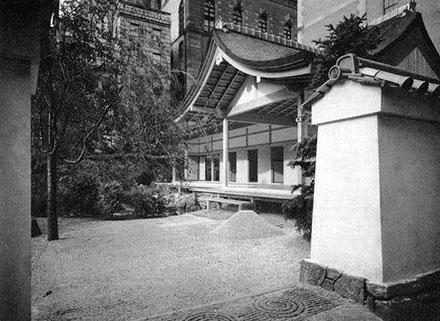
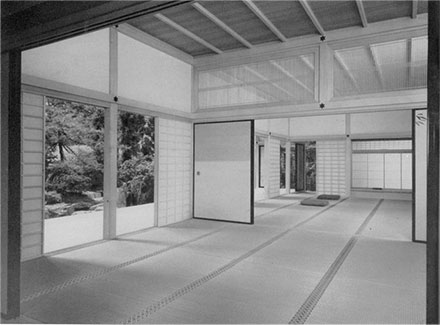
Japanese House and Garden, Museum of Modern Art, New York, 1954-1955
Thursday July 23
To conclude this unit, beginning on Thursday July 23 and continuing to Monday, July 27, Sarah Teasley, (Royal College of Art) will explore design's use in international relations in modern history: design as a diplomatic strategy, trade promotion device and export in its own right. The case study, Japanese design for European and American consumers, also highlights design's role in Western ideas of the 'exotic foreign'.
In three seminars, Teasley will consider the relationship between export products' design and exhibition and their overseas reception, as well as connections between domestic and export markets, in three significant moments: decorative industrial goods at international exhibitions in the 1870-80s; modernist craft and industrial design exports c. 1945-1960; and the relationship between Japanese design industries and the international and domestic promotion and reception of ‘Japanese design’ today.
The first two seminars will conclude with visits to the Philadelphia Museum of Art's collection of Japanese objects acquired at the Philadelphia Centennial Exhibition of 1876, and to Shofuso, formerly the Museum of Modern Art's Japanese House and Garden (1953-55) now located in Philadelphia's Fairmount Park. These field trips will provide concrete examples for discussion as will primary sources such as MoMA's catalogue for the Japanese House and Garden exhibition and current trade policy documents.
TThe three sessions are also intended as a case study in teaching core questions for history of design through ‘nontraditional’ geographies for Anglophone design history.
NOTE: At the time of this printing, we are working out details for the afternoon field trip to the Shofuso Japanese House and Garden – times may change in order to accommodate the site’s availability, so look for an upcoming announcement later in July.
9:30 – 12:15 PM. Sarah Teasley will present the first of three seminars on design’s role in international relations, trade and economic development, using modern Japanese design exports as a case study. This morning’s topic: design and the rebuilding of US-Japanese ties and the Japanese economy after the Second World War.
Given that much of the material presented has to some extent shaped contemporary perceptions of ‘Japanese’ and more generally ‘Asian’ design, this first session will also cover current discussions around how to define, teach and research ‘Asian design’.
- Essential Reading: Design Quarterly nos 51-52 ‘Japan: Design Today’ special issue, 1960, 3-13 and 48-57; Kikuchi, Yuko. 'Russel Wright and Japan: Bridging Japonisme and Good Design through Craft Design', Journal of Modern Craft , vol. 1, no. 3, 2008, 357-382; Kida, Takuya. ‘Japanese Crafts and Cultural Exchange with the USA in the 1950s: Soft Power and John D. Rockefeller III during the Cold War’, Journal of Design History vol. 25, no. 4, 2012, 379-399; Christine Guth, ‘Asian Design 101: Conceptual and Methodological Frameworks in Historicising Asian Design’, paper for the Asian Design: Histories, Collecting, Curating conference, M+, Hong Kong, 2012.
12:30 – 1:15 Break for lunch
1:30 – 4:30: Field Trip to the Shofuso Japanese House and Garden.
Friday July 24
9:30 AM - 12:15 PM. Sarah Teasley's 2nd in-depth seminar on design as a tool for diplomacy and economic development. Our case study: light industrial crafts from Japan at international expositions, c. 1860-1920.
- Essential Reading: Conant, Ellen P., ‘Refractions of the Rising Sun: Japan’s Participation in International Exhibitions 1862-1930’ in Sato, Tomoko, and Toshio Watanabe eds. Japan and Britain: An Aesthetic Dialogue, 1850-1930, London, Lund Humphries in association with Barbican Art Gallery and the Setagaya Art Museum, 1991, 72-92; Hida Toyojiro, ‘Exporters of Meiji Decorative Arts’ in Impey, Oliver ed. Meiji No Takara: Treasures of Imperial Japan Vol 1. Selected Essays, London, The Kibo Foundation, 1995, 70-94; Pollard, Clare, ‘Gorgeous with Glitter and Gold: Miyagawa Kozan and the Role of Satsuma Export Ware in the Early Meiji Ceramic Industry’ in Conant, Ellen P. ed. Challenging Past and Present: The Metamorphosis of Nineteenth-Century Japanese Art, Honolulu, University of Hawai'i Press, 2006, 133-152.
12:30 – 1:15 Break for lunch
1:30 – 4:30 PM: Field Trip to the Philadelphia Museum of Art to view its collection of Japanese craft and industrial design objects.
Weekend, July 25 and 26: Relax; Enjoy: Explore: Prepare!
Monday July 27
9:30 AM – 12:15 PM, URBN 345: Sarah Teasley will present a final in-depth seminar on the political and ethical dimensions of Japanese design exports today, internationally and from regions to urban consumers within Japan. The seminar will focus on methods and perspectives for engaging critically with the rhetoric around design practice and products today.
- Essential Reading: Ministry of Economy, Trade and Industry (Japan). "Cool Japan Initiative (Cool Japan Fund)", 18 November 2013; Daliot-Bul, Michal, ‘Japan Brand Strategy: The Taming of ‘Cool Japan’ and the Challenges of Cultural Planning in a Postmodern Age’, Social Science Japan Journal vol 12 no 2 (2009), 247-266; Yano, Christine, ch. 7 ‘Japan’s Cute-Cool as Global Wink’, Pink Globalization: Hello Kitty’s Trek Across the Pacific, Honolulu, University of Hawai’i Press 2014, 252-268; ‘TEMA HIMA: The Art of Living in Tohoku’, 21_21 Design Sight, exhibition website including all subsections: ‘About’, ‘Message’, ‘Exhibits’, ‘Related Programs’, ‘Related Information’ and ‘Profile’; Brandt, Kim, ch. 3 ‘New Mingei in the 1930s’, Kingdom of Beauty: Mingei and the Politics of Folk Art in Imperial Japan. Durham: Duke University Press, 2007, 83-123.
12:30 – 1:15 Break for lunch
1:30 – 4:15 PM: Group Research and Preparation (David, Carma, Sarah available for consultation)
Tuesday July 28
Group Presentations (3 each day, one in the morning, two in the afternoon). David and Carma will be present during each of the three participant presentation days to facilitate discussions after presentations
Presentation 1: 9:00- AM – 10:30
Q&A
Presentation 2: 11:00 AM – 12:30
Q&A
1:00 – 1:45 PM – Break for lunch
Presentation 3: 2:00 – 3:30 PM
Q&A
Wednesday July 29
Group Presentations (3 each day, one in the morning, two in the afternoon)
Presentation 1: 9:00- AM – 10:30
Q&A
Presentation 2: 11:00 AM – 12:30
Q&A
1:00 – 1:45 PM – Break for lunch
Presentation 3: 2:00 – 3:30 PM
Q&A
Thursday July 30
Group Presentations (3 each day, one in the morning, two in the afternoon)
Presentation 1: 9:00- AM – 10:30
Q&A
Presentation 2: 11:00 AM – 12:30
Q&A
1:00 – 1:45 PM – Break for lunch
2:00 – 4:00 PM – Time set aside in case of time over-runs and/or discussion
Friday July 31
10 AM – 12:00 PM: Wrap-up session with David and Carma
1:30 – 3:00 PM: Final comments, future plans for communication with participants and continued dialogue among visiting scholars, director, and summer scholars.